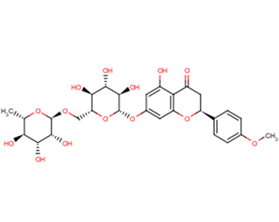
Didymin
CAS No. 14259-47-3
Didymin( —— )
Catalog No. M18013 CAS No. 14259-47-3
Didymin has antioxidant property. Didymin induces apoptosis by inhibiting N-Myc and upregulating RKIP in neuroblastoma, may used for neuroblastoma therapy.
Purity : >98% (HPLC)
 COA
COA
 Datasheet
Datasheet
 HNMR
HNMR
 HPLC
HPLC
 MSDS
MSDS
 Handing Instructions
Handing Instructions
| Size | Price / USD | Stock | Quantity |
| 5MG | 60 | In Stock |


|
| 10MG | 105 | In Stock |


|
| 100MG | Get Quote | In Stock |


|
| 200MG | Get Quote | In Stock |


|
| 500MG | Get Quote | In Stock |


|
| 1G | Get Quote | In Stock |


|
Biological Information
-
Product NameDidymin
-
NoteResearch use only, not for human use.
-
Brief DescriptionDidymin has antioxidant property. Didymin induces apoptosis by inhibiting N-Myc and upregulating RKIP in neuroblastoma, may used for neuroblastoma therapy.
-
DescriptionDidymin has antioxidant property. Didymin induces apoptosis by inhibiting N-Myc and upregulating RKIP in neuroblastoma, may used for neuroblastoma therapy. Didymin may be a potential therapeutic molecule for the treatment of neurodegenerative disorders associated with oxidative stress.
-
In VitroCell Proliferation Assay Cell Line:A549 and H460 cells Concentration:1 μM, 5 μM, 10 μM, 20 μM Incubation Time:48 h Result:Inhibited cell proliferation in human non-small-cell lung cancer cells.Apoptosis Analysis Cell Line:A549 and H460 cells Concentration:10 μM, 20 μM Incubation Time:12 h, 24 h, 48 h Result:Induced apoptosis in A549 and H460 cells, without affecting the cell cycle distribution.
-
In VivoAnimal Model:Male nude mice [6 weeks old; BALB/cA-nu (nu/nu)] injected with A549 cells Dosage:6 mg/kg/day Administration:i.p.; daily for 28 days Result:Inhibited tumor growth in nude mice.
-
Synonyms——
-
PathwayOthers
-
TargetOther Targets
-
RecptorOthers
-
Research AreaNeurological Disease
-
Indication——
Chemical Information
-
CAS Number14259-47-3
-
Formula Weight594.57
-
Molecular FormulaC28H34O14
-
Purity>98% (HPLC)
-
SolubilityIn Vitro:?DMSO : 250 mg/mL (420.48 mM)
-
SMILESC[C@H]1[C@@H]([C@H]([C@H]([C@@H](O1)OC[C@@H]1[C@H]([C@@H]([C@H]([C@@H](O1)Oc1cc(c2C(=O)C[C@H](Oc2c1)c1ccc(cc1)OC)O)O)O)O)O)O)O
-
Chemical Name——
Shipping & Storage Information
-
Storage(-20℃)
-
ShippingWith Ice Pack
-
Stability≥ 2 years
Reference
1. Morelli S, et al. Neuroprotective effect of didymin on hydrogen peroxide-induced injury in the neuronal membrane system. Cells Tissues Organs. 2014;199(2-3):184-200.
molnova catalog



related products
-
(R)-Reticuline
(R)-Reticuline is the biosynthetic precursor of the morphinan alkaloids.
-
CI 75300
CI 75300 targets the P2X purinoceptor 7 (human).
-
Antioxidant 245
——



 Cart
Cart
 sales@molnova.com
sales@molnova.com


